Article Archive
Thermal Infrared vs. Active Infrared: A New Technology Begins to be Commercialized
Jon L. Grossman
Hi-Tech Inspection Services, Inc.
7520 NW 54th Street
Miami, FL 33166
Ph: 305-639-1928
Abstract
What do most thermographers think the technology is when someone says “Active Thermography”? Obviously, most of us think that we are doing something to create a viable thermal infrared image. However, it seems that we need to retool our words and recalibrate our minds. This presentation will discuss the difference between Thermal-IR and Active-IR and, by example, demonstrate the differences not only in the wording but also in actual use.
Introduction
For the most part, as thermographers, we know we sometimes need to create a thermal delta to enhance or even obtain a thermal image. We call this Active-IR. It seems that there is a whole industry growing up around us, and maybe through us, that has a whole different concept as to what Active-IR is.1
In the world of thermography, Active-IR typically means to do something that will enhance the ![]() T. In most cases, as thermographers, we might do such things as add some heat, add some cold, inject a gas, create positive or negative air pressure, or even spray or paint on a substance to change an emissivity level to enhance or highlight an anomaly. To us, this is an act of active IR (thermography). To others outside of our industry, these actions are not clearly understood and are mostly ignored.
T. In most cases, as thermographers, we might do such things as add some heat, add some cold, inject a gas, create positive or negative air pressure, or even spray or paint on a substance to change an emissivity level to enhance or highlight an anomaly. To us, this is an act of active IR (thermography). To others outside of our industry, these actions are not clearly understood and are mostly ignored.
This other industry has refined the definition of “active” when it comes to IR for their particular world and it seems we need to redefine, retool and recalibrate the term for our world so that confusion does not exist.
Discussion
Let’s take a look at some basic thermographic facts:
-
Infrared imagers have been in the marketplace for more than 50 years
-
Infrared imagers are extremely useful as a tool in locating and diagnosing all sorts of anomalies, so long as a sufficient ?T is present
-
Infrared imagers are best utilized by trained and experienced personnel
-
Infrared imagers have the ability, even in marginal performance levels, such as fog, rain, mist, and sand to provide useful imagery
-
Infrared imagers cannot “see” through windows or many other translucent materials
-
Infrared imagers are passive; they cannot change the characteristics of the subject object or provide any illumination
-
Infrared imagers can help detect activity, but in most cases cannot define that activity
-
Now, let’s address this other technology and look at the new definition of this term, “Active-IR”.
The new technology that is using the term Active-IR is focused around the use of CCTV-type camera equipment, particularly in surveillance systems. Their use of the term IR, as part of their definition, is the use of light in the 695 nm to 1,000 nm wavelengths. These camera devices illuminate targets’ scenes at wavelengths that are invisible to the human eye (near IR and IR range). This new industry has defined “Active-IR” as the use of invisible infrared light to illuminate a scene or subject and capture it, utilizing a CCTV-type camera.
Since there are many more vendors and users of surveillance-type equipment than there are thermographic equipment vendors and users, this new industry would have thermographers change our terminology. To the surveillance industry, we should adopt the term “Thermal-IR” when we are referring to thermography and use the term “Active Thermal-IR” when we are artificially creating a greater ?T. That would leave the term Active-IR to the surveillance industry when they use cameras using an infrared illumination assist.
Additionally, the surveillance industry is quick to point out that:
-
Thermal-IR equipment is passive
-
Nightvision equipment is passive
-
Active-IR equipment is active
So, let’s take a look at this new industry and some of the positives as well as negatives of “Active-IR” technology:
-
Active-IR technology is already proven
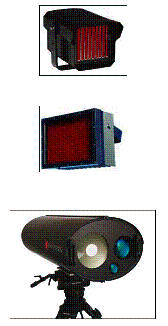
-
It is an effective, low-cost means for nighttime surveillance systems
-
Active-IR does rely upon there being sufficient IR light illuminating a scene
-
Active-IR devices illuminate targets’ scenes with illumination that is invisible to the human eye
-
Active-IR illuminators can illuminate shadows, reveal identifying letters / numbers, such as license plates and objects, while outperforming ICCD’s (intensified cameras) and Thermal-IR devices
-
Nightvision technology encompasses ambient light and intensified CCD cameras (passive technology), not Active-IR
-
Active-IR devices do not require a ?T
-
Active-IR devices can see through glass and other translucent materials
-
CCTV technology has a significantly greater resolution than Thermal-IR devices
-
Active-IR devices, in most cases, can decipher friend or foe at both long range or short range distances
-
Thermal-IR devices are great for finding warm people and warm vehicles. Active-IR devices are great for defining who and what those people, vessels and vehicles are
-
One of the difficulties with Active-IR devices is they need to properly illuminate the subject at the required distance. There are several different technologies that can be used to assist in illuminating the subject:
-
Bulb type: 110V high voltage or 28V low voltage type bulbs
- The state-of-the-art is the low-voltage quartz halogen, patented even-illumination UF500
-
LED type: Regular or supercharged
- The state-of-the-art is the low voltage supercharged Super LED
-
Laser type: Continuous mode or pulsed range-gated mode
-
The state-of-the-art is the Dalis range-gated model by Observ
-
Range-gated pulsed laser techniques safely illuminate and can get the picture at 5 km, 10 km, and 20 km
-
Can see through nighttime fog, mist, rain, and snowfall
-
-
-
Active-IR LED illumination can be continuously pulsed for fast shutter speed synchronization with cameras for high-speed video capture
-
Active-IR illuminators are currently available in a range of wavelengths: 695 nm, 730 nm, 850 nm, and 950 nm, etc.
-
When used for surveillance, most Active-IR pictures are permissible in courts of law because of their high resolution and high definition quality, whereas most thermal imaging is not
Active-IR illuminated CCTV images have a better resolution than thermal IR images and this segment of the security industry is rapidly growing. The need to see in the dark is critical, but to define what you see in the dark is even more critical. One can expect to see significant advances in the cameras, the lenses, the DVR’s and the software that drives these systems to work with Active-IR illumination.
After understanding the positives and negatives of Active-IR, it becomes clear that there are many applications for this technology.
Integrated Day / Night Surveillance
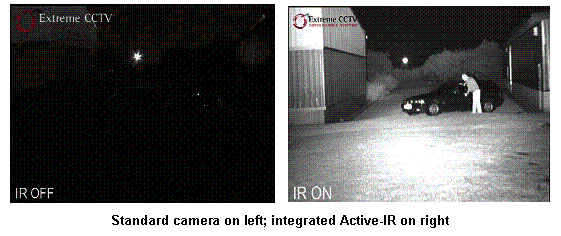
1. Mobile capture at speeds up to 30 mph
2. High speed capture of license plates (up to 100 mph), can include automatic license plate recognition
3. HAZMAT / explosion-proof housings
4. Long range day / night surveillance (up to 12 miles)
5. Defense / Homeland security
6. Parking enforcement
7. Intelligent transportation systems
8. Highway rest stops
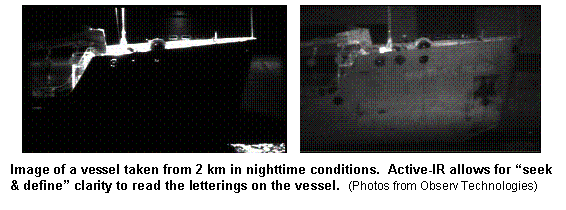
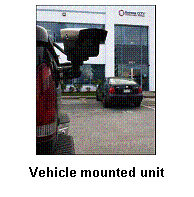 9. Tunnel surveillance
9. Tunnel surveillance
10. Transit systems
11. Public parking lots / structures
12. Facial recognition
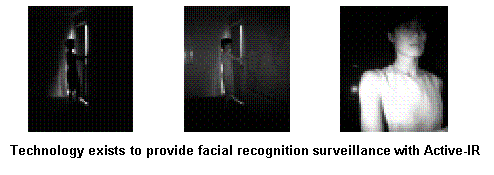
13. Prisons
14. Hospitals
15. Power plant security
16. Shipping container tracking
 Non-Security Surveillance Applications of Active-IR Technology
Non-Security Surveillance Applications of Active-IR Technology
In October 2006, a new Active-IR system was introduced to the marketplace. The system was designated as a Critter Activity Tracking System, (CATS). It was designed to be utilized by two different industries.
The first being the pest management professional who would use the system to make a determination of the existence and identification of critters either inside a facility or near the outside perimeter of a facility. Such critters can be defined as any unwelcome or unidentified animal or pest that is intruding into a defined area. Some typically observed critters include: 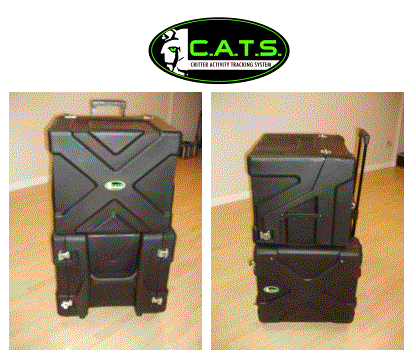 rats, mice, raccoons, possums, bats, feral cats, weasels and other four-legged and flying critters. For the pest management professional, it is important to not only understand what type of critter is entering or trying to enter a facility, but also what paths and routes are being used in order for the PMP to provide proper treatment and preventive or exclusionary measures.
rats, mice, raccoons, possums, bats, feral cats, weasels and other four-legged and flying critters. For the pest management professional, it is important to not only understand what type of critter is entering or trying to enter a facility, but also what paths and routes are being used in order for the PMP to provide proper treatment and preventive or exclusionary measures.
The other application is for use by health departments. The system, small and portable by design, will help determine whether any particular eating establishment has rodents or insects present that are not permitted under the health department sanitary regulations.
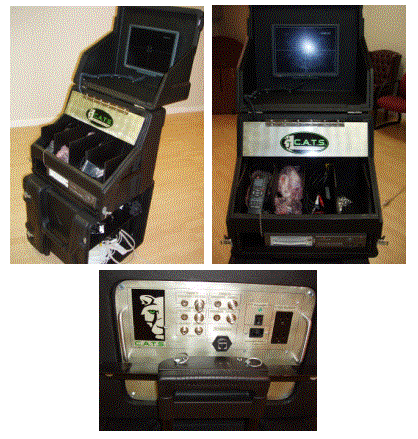 The first CATS model that was introduced by Hi-Tech Inspection Services, Inc. (Miami, FL) at the National Pest Control Association Annual Convention (October 2006), was a portable 4-camera system that could be wheeled into a facility and could be set up within minutes.
The first CATS model that was introduced by Hi-Tech Inspection Services, Inc. (Miami, FL) at the National Pest Control Association Annual Convention (October 2006), was a portable 4-camera system that could be wheeled into a facility and could be set up within minutes.
The system consists of two parts. The lower “storage compartment” to which a luggage rack and wheels were integrated to provide portability, contains all the required electronic cabling and camera tripods to permit the positioning of each camera up to a 300 foot distance away from the system.
The upper portion was attached to the lower portion by means of a series of locator and locking pins and it housed the “brains” of the system, the cameras, video recorders and accessory illuminators that could be used by the system.
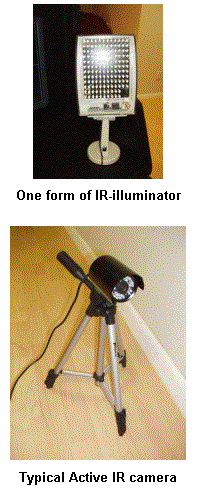 Since the cameras are all-weather, they could be placed inside or outside of the facility. The system has a built-in LCD screen that permits the operator to set up the cameras properly and an integrated programmable DVR with an 80 gig hard drive which would make and store recordings of any activity that was seen by any of the cameras. In addition, the system was designed to operate on motion detection, so that recording time would not be wasted when there was no activity.
Since the cameras are all-weather, they could be placed inside or outside of the facility. The system has a built-in LCD screen that permits the operator to set up the cameras properly and an integrated programmable DVR with an 80 gig hard drive which would make and store recordings of any activity that was seen by any of the cameras. In addition, the system was designed to operate on motion detection, so that recording time would not be wasted when there was no activity.
Once the system was set up and programmed, the operator could lock the system and leave. For the duration of the project, the system would operate on a programmed schedule and when the operator returned, he could interrogate the system for any activity seen. The stored results could then be downloaded from the DVR either onto a removable DVR or onto a flash memory device for remote viewing and report writing at a later time.
This particular CATS system has the ability to connect four (4) Active-IR cameras as well two (2) 110V receptacles, a network connection, and a USB port.
The CATS system is available in 4, 8, 16 and 32 camera configurations and is capable of being programmed by date, time, or time and motion and has the ability to send out an alarm over the internet.
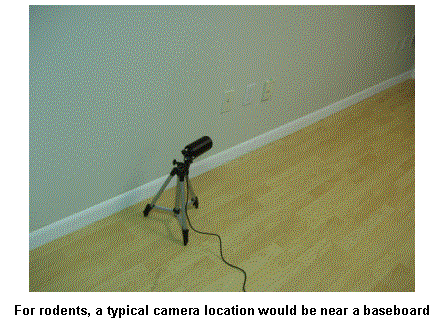
As is the use of all technologies, it is important to understand that each technology has its place in the mix of things. Looking at the following gallery images will give you a good idea of what technology might be appropriate for some applications but not others.

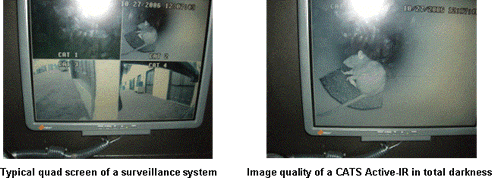
Conclusion
In conclusion, it appears that we as thermographers need to be cognizant of this new industry and the terminology being used. For the vast majority of us, this information will provide us with some insights into a new technology and may provide us with a solution for a future problem. At the very least, we have become more knowledgeable about the uses of infrared and how it is changing the world we live in.
References
1A significant portion of the Thermal-IR and Active-IR information and images in the Active-IR section contained in this paper was obtained from articles/papers written by J. M. (Jack) Gin, Extreme CCTV Surveillance Systems. Mr. Gin is the founder and President/CEO of Extreme CCTV and is world recognized as a leading expert in Active-IR technologies.
Advertisement


